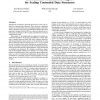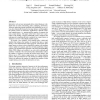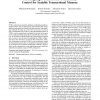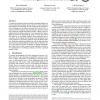PPOPP
2016
ACM
9 years 13 days ago
2016
ACM
PPOPP
2016
ACM
9 years 13 days ago
2016
ACM
Precise dynamic race detectors report an error if and only if more than one thread concurrently exhibits conflict on a memory access. They insert instrumentations at compiletime ...
PPOPP
2016
ACM
9 years 13 days ago
2016
ACM
High memory contention is generally agreed to be a worst-case scenario for concurrent data structures. There has been a significant amount of research effort spent investigating ...
PPOPP
2016
ACM
9 years 13 days ago
2016
ACM
We introduce OPTIK, a new practical design pattern for designing and implementing fast and scalable concurrent data structures. OPTIK relies on the commonly-used technique of vers...
PPOPP
2016
ACM
9 years 13 days ago
2016
ACM
Parallel accelerators such as GPUs are notoriously hard to program; exploiting their full performance potential is a job best left for ninja programmers. High-level programming la...
PPOPP
2016
ACM
9 years 13 days ago
2016
ACM
Interactive web services increasingly drive critical business workloads such as search, advertising, games, shopping, and finance. Whereas optimizing parallel programs and distri...
PPOPP
2016
ACM
9 years 13 days ago
2016
ACM
NUMA architectures posed the challenge of rethinking parallel applications due to the non-homogeneity introduced by their design, and their real benefits are limited to the chara...
PPOPP
2016
ACM
9 years 13 days ago
2016
ACM
Concurrency bugs that stem from schedule-dependent branches are hard to understand and debug, because their root causes imply not only different event orderings, but also changes ...
PPOPP
2016
ACM
9 years 13 days ago
2016
ACM
This paper presents ESTIMA, an easy-to-use tool for extrapolating the scalability of in-memory applications. ESTIMA is designed to perform a simple, yet important task: given the ...
PPOPP
2016
ACM
9 years 13 days ago
2016
ACM




